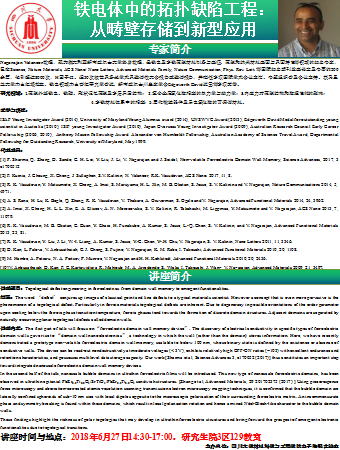专家简介:
Nagarajan Valanoor教授,现为澳大利亚新南威尔士大学终身教授,是铁电及多铁薄膜材料制备与表征、薄膜和纳米材料表面与界面特性等领域的知名专家,已在Science, Nature Materials, ACS Nano/ Nano Letters, Advanced Materials Family, Nature Communication, Phys. Rev. Lett. 等国际知名期刊发表论文及专著约200余篇,他引超过8000次,H因子42。近30次被世界各地学术界邀请做大会报告或邀请报告,并担任多项国际学术会议主席、专题组织者及会议主持。获马里兰大学杰出年轻校友、铁电领域杰出青年研究学者奖、新南威尔士州皇家学会Edgeworth David奖章等多项荣誉。
研究领域:1.薄膜外延铁电、铁磁、形状记忆薄膜及多层异质结构; 2.复合金属氧化物相变的热力学与动力学;3.内应力对薄膜结构和物理性能的影响;
4.多铁材料体系中的相变;5.用作微波器件及导电氧化物的可调谐材料。
荣誉与获奖:
ISAF Young Investigator Award (2014), University of Maryland Young Alumnus award (2014), UNSW VC Award (2013), Edgeworth David Medal for outstanding young scientist in Australia (2010), ISIF young Investigator Award (2010), Japan Overseas Young Investigator Award (2009), Australian Research Council Early Career Fellowship (2006, 2010), Anthony Mason Fellowship Award Alexander von Humboldt Fellowship, Australian Academy of Science Travel Award, Departmental Fellowship for Outstanding Research, University of Maryland, May 1999.
代表成果:
[1] P. Sharma, Q. Zhang, D. Sando, C. H. Lei, Y. Liu, J. Li, V. Nagarajan and J. Seidel, Non-volatile Ferroelectric Domain Wall Memory, Science Advances, 2017, 3 e1700512
[2] F. Kurnia, J. Cheung, X. Cheng, J. Sullaphen, S.V. Kalinin, N. Valanoor, R.K. Vasudevan, ACS Nano. 2017, 11, 8.
[3] R. K. Vasudevan, Y. Matsumoto, X. Cheng, A. Imai, S. Maruyama, H. L. Xin, M. B. Okatan, S. Jesse, S. V. Kalinin and V. Nagarajan, Nature Communications 2014, 5, 4971.
[4] A. S. Rana, H. Lu, K. Bogle, Q. Zhang, R. K. Vasudevan, V. Thakare, A. Gruverman, S. Ogale and V. Nagarajan, Advanced Functional Materials 2014, 24, 3962.
[5] A. Imai, X. Cheng, H. L. L. Xin, E. A. Eliseev, A. N. Morozovska, S. V. Kalinin, R. Takahashi, M. Lippmaa, Y. Matsumoto and V. Nagarajan, ACS Nano 2013, 7, 11079.
[6] R. K. Vasudevan, M. B. Okatan, C. Duan, Y. Ehara, H. Funakubo, A. Kumar, S. Jesse, L.-Q. Chen, S. V. Kalinin, and V. Nagarajan, Advanced Functional Materials 2013, 23, 81.
[7] R. K. Vasudevan, Y. Liu, J. Li, W.-I. Liang, A. Kumar, S. Jesse, Y.-C. Chen, Y-.H. Chu, V. Nagarajan, S. V. Kalinin, Nano Letters 2011, 11, 3346.
[8] D. Kan, L. Palova, V. Anbusathaiah, C. J. Cheng, S. Fujino, V. Nagarajan, K. M. Rabe, I. Takeuchi, Advanced Functional Materials 2010, 20, 1108.
[9] M. Hambe, A. Petraru, N. A. Pertsev, P. Munroe, V. Nagarajan and H. H. Kohlstedt, Advanced Functional Materials 2010, 20, 2436.
[10] V. Anbusathaiah, D. Kan, F. C. Kartawidjaja, R. Mahjoub, M. A. Arredondo, S. Wicks, I. Takeuchi, J. Wang, V. Nagarajan, Advanced Materials 2009, 21, 3497.
讲座简介
讲座题目:Topological defect engineering in ferroelectrics: from domain wall memory to emergent functionalities.
摘要:The word ‘defect’ conjures up images of classical point and line defects to a typical materials scientist. However a concept that is even more pervasive is the phenomenon of a topological defect. Particularly in ferroic materials topological defects are inherent. Due to degeneracy in possible orientations of the order parameter upon cooling below the ferroic phase transition temperature, ferroic phases tend towards the formation of discrete domain structures. Adjacent domains are separated by naturally occurring planar topological defects called domain walls.
讲座内容:The first part of talk will focus on “ferroelectric domain wall memory device”. The discovery of electrical conductivity in specific types of ferroelectric domain walls gave rise to “domain wall nanoelectronics”, a technology in which the wall (rather than the domain) stores information. Here, we have recently demonstrated a prototype non-volatile ferroelectric domain wall memory, scalable to below 100 nm, whose binary state is defined by the existence or absence of conductive walls. The device can be read-out nondestructively at moderate voltages (< 3 v), exhibits relatively high off-on ratios (~103) with excellent endurance and retention characteristics, and possesses multilevel data storage capacity. our work [sharma et al, science advances 3, e170052 (2017)] thus constitutes an important step toward integrated nanoscale ferroelectric domain wall memory devices.
In the second half of the talk, nanoscale bubble domains in ultrathin ferroelectric films will be introduced. This new type of nanoscale ferroelectric domains, has been observed in ultrathin epitaxial PbZr0.2Ti0.8O3/SrTiO3/PbZr0.2Ti0.8O3 sandwich structures. [Zhang et al, Advanced Materials, 29 201702375 (2017) ] Using piezoresponse force microscopy and aberration-corrected atomic-resolution scanning transmission electron microscopy mapping techniques, it is confirmed that the bubble domain are laterally confined spheroids of sub-10 nm size with local dipoles opposite to the macroscopic polarization of their surrounding ferroelectric matrix. An incommensurate phase and symmetry breaking is found within these domains, which result in local polarization rotation and hence a mixed Néel-Bloch-like character to the bubble domain walls.
These findings highlight the richness of polar topologies that may develop in ultrathin ferroelectric structures and bring forward the prospect of emergent electronic functionalities due to topological transitions.
讲座时间与地点:2018年6月27日14:30-17:00,研究生院3区129教室
主办单位:四川大学材料科学与工程学院电子陶瓷实验室
